Welcome to the world of high-density banana plantations! If you’re a banana enthusiast or a farmer looking to maximize your yield and profits, this blog is for you. This article will explore the fascinating techniques, spacing requirements, and plant yield in high-density banana plantations. Adopting these innovative methods can significantly increase your productivity while efficiently utilizing your land. Get ready to discover the benefits of planting more bananas per acre, the optimal spacing guidelines, and the techniques that can boost your yield.
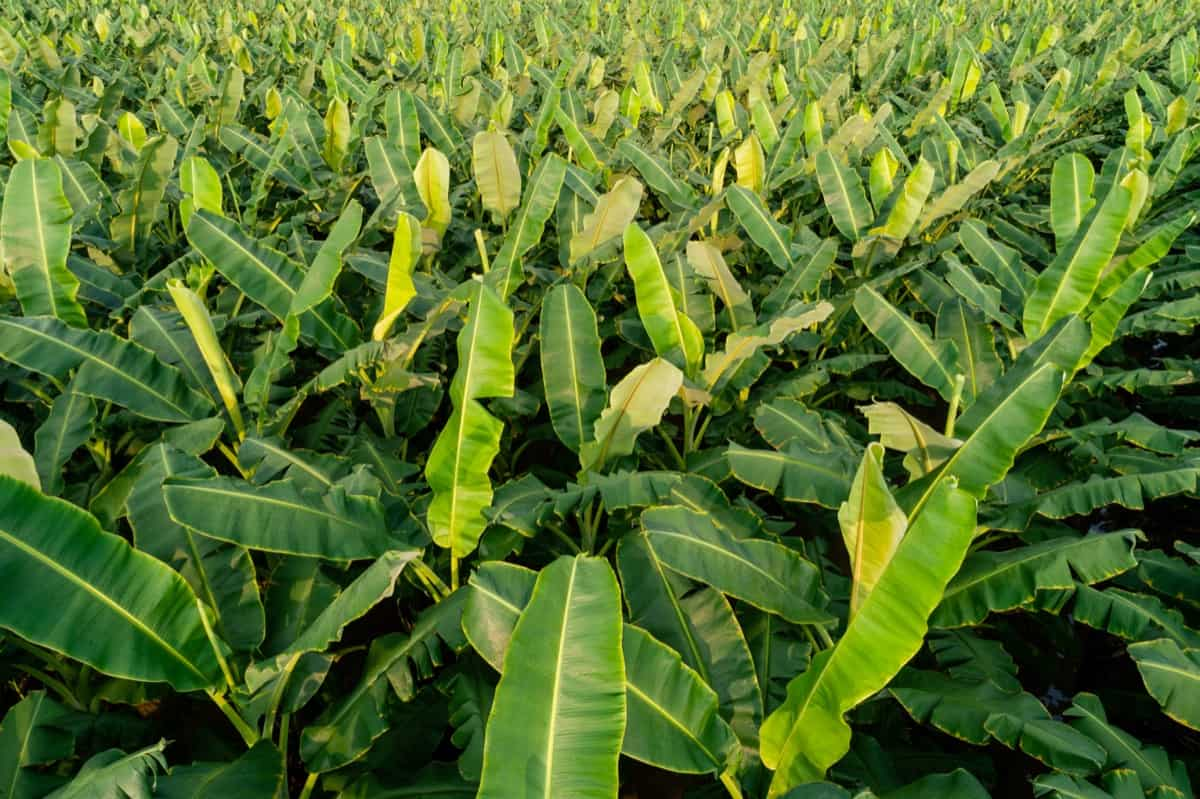
Introduction to Banana Farming and Production
A Banana (Musa sapientum) is a fast-growing plant with a succulent stem, commonly mistaken as a tree. It has a cylindrical shape made up of leaf-petiole sheaths, reaching a height of 6-7.5 meters. Native to the Indo-Malaysian region, bananas are now cultivated in various humid tropical areas, including Bangladesh. Bananas are highly nutritious and rich in ascorbic acid (vitamin C), vitamin B6, and potassium.
Commercial banana cultivation typically follows a spacing of 2 meters by 2 meters. Bananas and plantains are grown in approximately 120 countries, with a global annual production of around 86 million tonnes. India is the leading producer, with an output of about 14.2 million tonnes, followed by countries like Brazil, Ecuador, China, the Philippines, Indonesia, Costa Rica, Mexico, Thailand, and Colombia.
In India, banana ranks first in production and third in the area among fruit crops. Maharashtra has the highest productivity of 65 metric tonnes per hectare, while Tamil Nadu has the highest production at 3,543.8 thousand tonnes. Banana is economically important due to its low cost, high nutritional value, and versatility in various processed products.
What is High-Density Banana Plantation?
High-density banana plantation refers to a modern cultivation method that involves planting more banana plants per acre than traditional methods. Instead of spacing them farther apart, high-density planting utilizes closer spacing, allowing for more plants in a given area. This innovative technique can result in increased productivity and improved land utilization. Typically, high-density banana plantations have approximately 1,600 to 1,800 plants per acre compared to traditional plantations. This higher plant density contributes to higher yields and potential profits for farmers.
Banana Plantation Market Trends
Bananas are primarily consumed domestically, with only a small percentage being exported. The Agriculture Marketing Board of Maharashtra established ‘Mahabanana’ to improve marketing practices. Maharashtra’s Jalgaon district has developed a well-organized banana industry through high-density planting.
The Azadpur market in Delhi plays a significant role in banana distribution. India’s main export markets include the Middle East, with emerging markets in Russia, China, and Eastern Europe. The industry has growth potential through improved cultivation practices, post-harvest technologies, and value-added product development, such as dehydration and beverages.
High-Density Banana Plantation Techniques
- High-density banana plantation techniques involve different systems of planting. In the single-row system, the distance between plants within the row is close, while the distance between rows is wide.
- This allows better aeration, faster drying of wet leaves, and reduced fungal disease severity. However, the yield may be lower due to fewer trees in the field.
- The distance between two lines in the paired row system is 0.90 to 1.20 meters, while between plants within a row is 1.2 to 2 meters. This spacing facilitates easy intercultural operations and reduces the cost of drip irrigation.
- The square system is the most commonly used method, with a spacing of 1.8×1.8 meters. Trees are planted at the corners of a square, allowing for intercropping and cultivation in two directions. The central space between four trees can be utilized for short-lived filler trees.
- For tissue culture banana suckers, the triangular system is well-suited. The spacing between rows is 1.5 meters, and the distance between plants and row is 1.8 meters. Trees in even-numbered rows are midway between those in odd rows, optimizing space utilization. Each tree occupies more area than the square system, resulting in fewer trees per hectare.
In case you missed it: Nendran Banana Production in India: Cultivation Practices and Farming Management
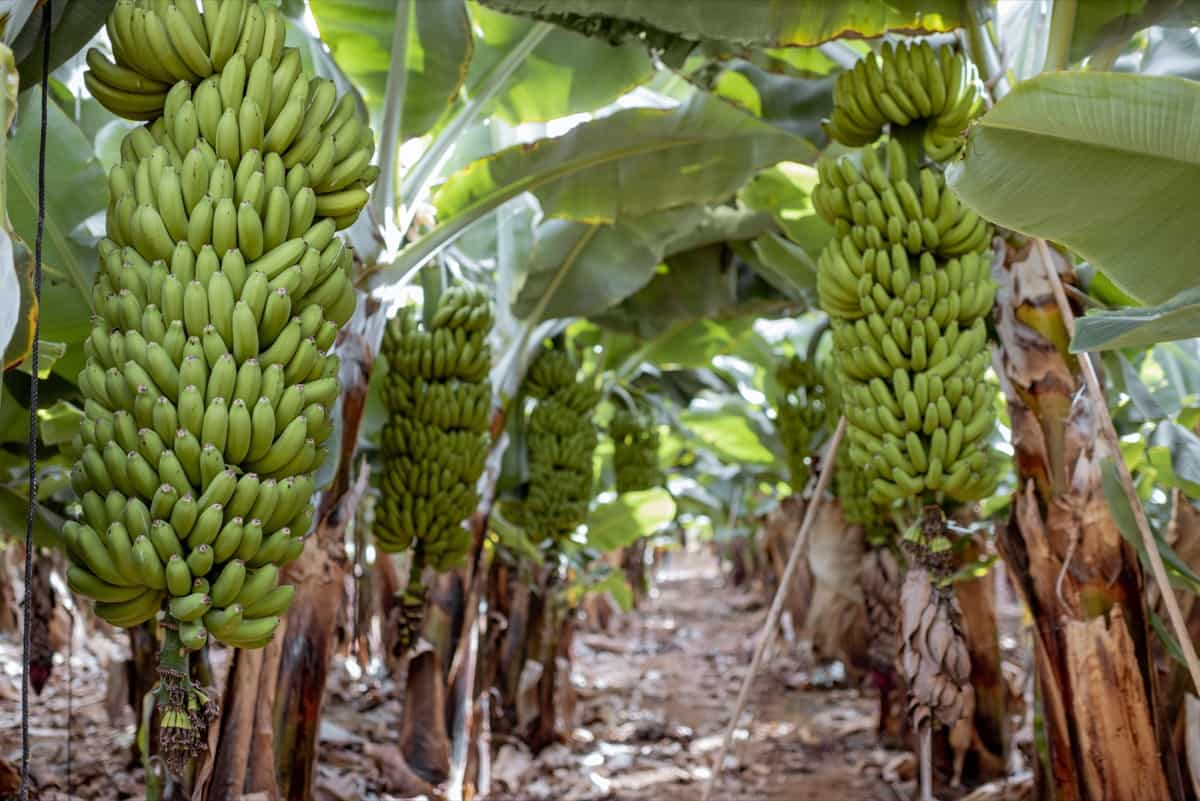
High-Density Banana Plantation Varieties
In high-density banana plantations, different varieties offer varying planting densities and corresponding yields. For the Robusta variety, a spacing of 1.5 meters by 1.5 meters allows for 4,400 plants per hectare, yielding 120 tons per hectare. The Dwarf Cavendish variety also requires the same spacing and yields 100 tons per hectare with 4,400 plants.
In the case of Ney Poovan, a triangular planting pattern with a spacing of 1.5 meters by 1.5 meters is recommended, accommodating 5,120 plants per hectare. Represents a 16% increase compared to the 4,440 plants per hectare achieved with the standard square planting pattern.
High-Density Banana Plantation Soil Requirements
Bananas thrive in tropical climates with temperatures ranging from 15ºC to 35ºC and relative humidity of 75-85%. They prefer deep, rich loamy soil with a pH between 6.5 and 7.5. Good drainage, fertility, and moisture retention are essential for banana cultivation. Saline, calcareous soils are unsuitable for growing bananas.
The ideal soil is neutral, rich in organic matter, high in nitrogen, and contains sufficient phosphorus and potash. Bananas require a monsoon period of four months with an average rainfall of 650-750 mm for vigorous vegetative growth. At higher altitudes, banana cultivation is limited to specific varieties suitable for those conditions, such as ‘Hill banana.’
High-Density Banana Plantation Climate Considerations
Bananas require a tropical climate for successful cultivation, with temperatures ranging from 15ºC to 36ºC and relative humidity between 75% and 85%. They are grown in lowland areas up to 2000m above mean sea level. In India, bananas are cultivated in various climates, from humid tropical regions to dry, mild subtropics, by selecting suitable varieties. Chilling temperatures below 12ºC can cause damage to the crop, while high wind speeds exceeding 80 km/hr can also be detrimental.
High-Density Banana Plantation Spacing
High-Density Planting
- Paired row planting system for dwarf varieties (Grand Naine, Poovan, Rasthali, Ney Poovan):
- Spacing: 1.2m x 1.2m x 2.0m
- Population: 5200 plants/ha
- Spacing: 1.5m x 1.5m x 2.0m
- Population: 3850 plants/ha
Three Suckers Per Hill (Grand Naine, Nendran, Rasthali)
- Spacing: 1.8m x 3.6m
- Population: 4600 plants/ha
- Spacing: 1.8m x 3.0m
- Population: 5550 plants/ha
Two Plants Per Hill (Ney Poovan, Poovan, Rasthali, Nendran, Monthan)
- Spacing: 2.1m x 2.4m
- Population: 3525 plants/ha
- Spacing: 2.1m x 2.7m
- Population: 3960 plants/ha
The number of plants per hectare in a high-density planting system can range from 3850 to 5200, based on the specific spacing and variety used.
In case you missed it: Robusta Banana Farming in India: Cultivation Practices and Production Management
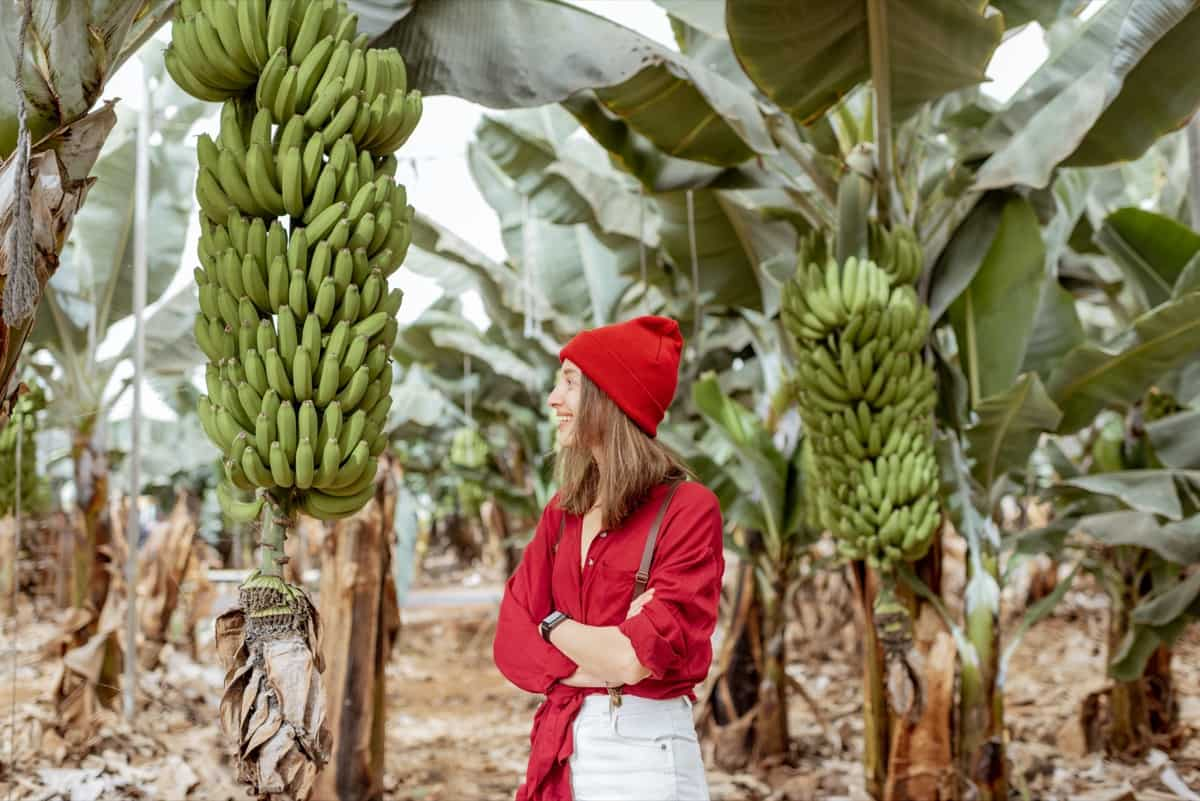
High-Density Banana Plantation Irrigation
Water requirement for high-density banana plantations through drip irrigation varies during growth. These quantities indicate the approximate water requirements per plant for each growth stage when using drip irrigation in high-density banana plantations.
- After planting/Ratoon (1-4 weeks): 4-6 liters of water per plant
- Juvenile phase (5-9 weeks): 8-10 liters of water per plant
- Critical growth stage (10-19 weeks): 12 liters of water per plant
- Flower bud differentiation stage (20-32 weeks): 16 liters of water per plant
- Shooting stage (33-37 weeks): 20 liters and above* per plant
- Bunch development stage (38-50 weeks): 24 liters and above* per plant
Increasing Yield in High-Density Banana Plantation
High-Density Planting (HDP) involves planting at a closer spacing than the usual recommended spacing. The correct planting density is crucial to bridge the gap between actual and potential banana yields. Optimum plant density varies based on factors such as location, cultivar, soil fertility, management level, climate, and plantation vigor. Light interception and energy conversion efficiency are influenced by planting density, with 1.2m x 1.2m spacing showing maximum energy conversion efficiency.
Plant height and girth are affected by spacing, with reduced spacing resulting in taller pseudostems and smaller girth. Leaf number and leaf area index (LAI) correlate with optimum density, and closer spacing can decrease leaf emergence. Sucker production is higher with wider spacing, while root growth initially increases with plant density but declines later.
Optimal Fertilization for High-Density Banana Plantation
Implementing high-density planting combined with drip irrigation and a weekly fertilization schedule for banana cultivation has improved resource utilization efficiency. This approach has resulted in significant savings of 30-40% in irrigation water and 25% in fertilizers compared to conventional methods. Increase production, productivity, and fruit quality while reducing the overall cost of cultivation. The recommended fertigation schedule for bananas, measured in grams per plant per week, is as follows:
Weeks after Planting
- 9 to 18 weeks (10 weeks): 15g of urea and 8.0g of MOP (Muriate of Potash)
- 19 to 30 weeks (12 weeks): 10g of urea and 10g of MOP
- 31 to 40 weeks (10 weeks): 7.0g of urea and 12g of MOP
- 41 to 46 weeks (5 weeks): No fertilization with urea and 10g of MOP
- Over the entire duration, the total fertilizer application per plant is 340g of urea and 375g of MOP.
In case you missed it: Yelakki Banana Farming in India: Production and Cultivation Management Practices
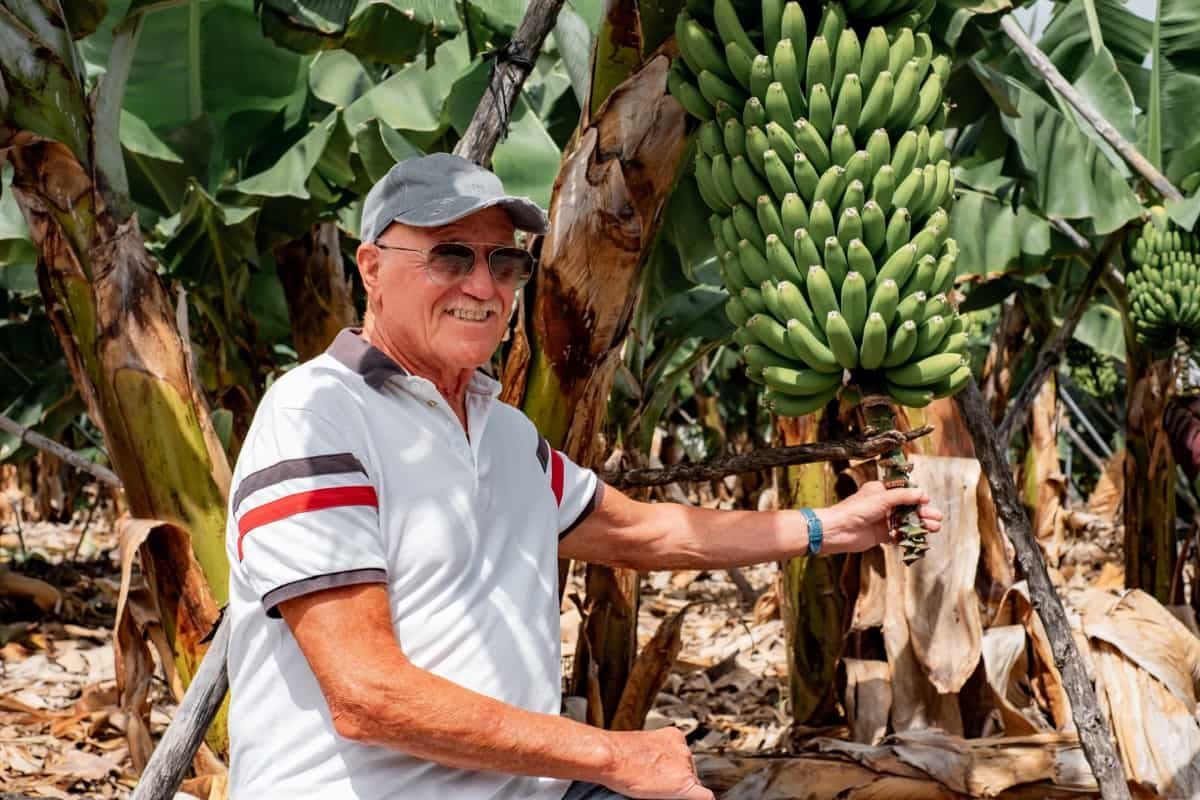
Sustainable and Best Practices for High-Density Banana Plantation
Planting: Banana planting can be done in May-June or September-October, avoiding severe winter and heavy rainy periods. Single suckers are planted upright in small pits, leaving 5 cm of pseudostem above the soil. Tissue culture plants are planted at ground level on top of the pit after removing the poly cover without damaging the roots. Light irrigation is provided after planting, and partial shade should be provided immediately.
Pre-treatment of suckers: Roots and decayed portions of the corm are trimmed, and the pseudostem is cut, leaving 20 cm from the corm. Suckers are graded by size. For wilt-susceptible varieties, infected parts of the corm can be pared and dipped in a 0.1% Emisan solution.
Desuckering: Regular removal of small suckers (unwanted shoots) helps reduce competition with the main plant and should be done up to 7-8 months after planting.
Propping: To support the bunch’s heavy weight, the plant’s leaning side should be propped using two bamboo poles, forming a triangle. This ensures balance and uniform development of the bunch.
Bunch cover & spray: Covering the bunch with dried leaves protect it from direct sunlight and improves fruit quality. However, this practice should be avoided during the rainy season. Sleeving the bunch with transparent and perforated polythene sheets, combined with neem cake application, can protect against dust, spray residue, insects, and birds.
Dehandling of false hands of the bunch: Incomplete hands that do not meet quality standards should be removed after bloom. This improves the weight of other hands, finger size, and skin-to-pulp ratio, meeting export standards.
Mulching: Using wheat straw or banana straw as mulch (12.5 kg/plant) helps increase bunch weight and conserve soil moisture. Mulch should be applied at the beginning of summer.
Inter-cropping: While the banana root system is sensitive to cultivation, short-duration crops like mung beans, cowpeas, and daincha can be grown as green manure. Leguminous crops, beetroot, elephant foot yam, ginger, turmeric, and sunnhemp can be intercropped during the first 3-4 months. Avoid growing cucurbitaceous vegetables as they can harbor viruses.
Growth regulators: Spraying 2,4-D at 25 ppm after the last hand has opened help improve bunch grade and remove seeds in certain varieties. CCC (1000 ppm) and plantozyme can be sprayed to achieve a higher yield.
Other farm operations: Remove dry leaves but avoid removing green leaves. Protect the plantation from strong winds by growing tall plants along the farm border. Use bamboo or eucalyptus poles for plant support. Irrigate or smoke the plantation during winter if the temperature drops below 10°C. Applying neem cake (1 kg per plant) during winter can aid in bunch formation.
In case you missed it: Grand Nain (G9) Banana Farming in India: A Cultivation Guide to Planting to Harvesting
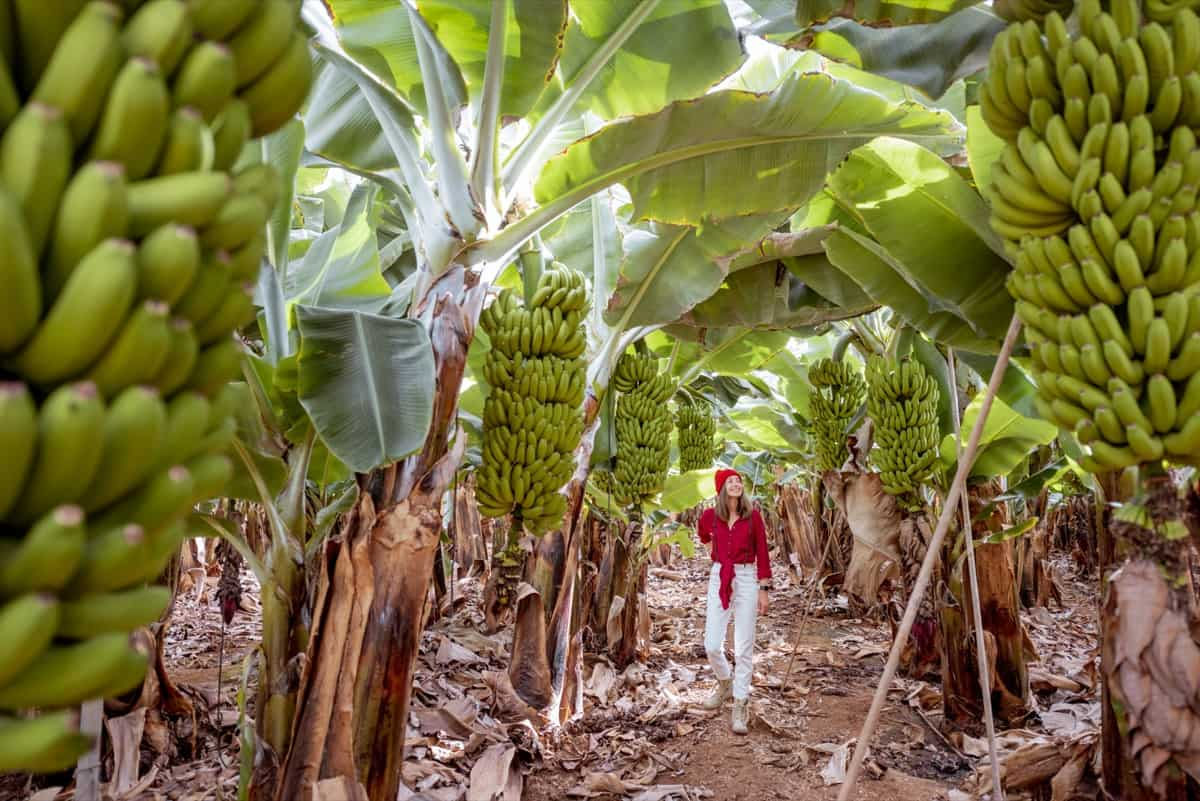
Maximizing Profits in High-Density Banana Plantation
- Accommodating more plants per unit area allows for higher yields and increased profitability.
- Wider spacing and easy fertigation result in lower initial investment in drip systems, reducing costs.
- More efforts for clump management lead to reduced cultivation expenses.
- Efficient use of resources: Water savings of 30-40%, fertilizer savings of 25%, and fewer plant protection chemicals required.
- Plant proximity provides natural wind protection, reducing potential damage.
- Cost savings on staking: Three plants can be secured with a single rope.
- Improved fruit quality and productivity: Yield increases by 40-50%.
- Opportunities for intercropping due to wider inter-row spacing and reduced weed growth add to the overall profitability of the plantation.
Managing Pests in High-Density Banana Plantations
Insect pests commonly observed in high-density banana plantations include rootstock/rhizome weevil, stem borer, thrips, banana beetle, aphid, and nematodes. Effective pest control measures include selecting healthy planting material, implementing appropriate intercultural operations, and applying suitable insecticides such as endosulfan, carbaryl, or monocrotophos based on the type of pest infestation.
Common diseases in high-density banana plantations include Panama wilt, anthracnose, leaf spot (Sigatoka), shoot rot, and viral diseases. Disease-free planting material should be used, and infected plant parts must be destroyed. Spraying with Bordeaux mixture, copper oxychloride, or carbendazim at 1% concentration has shown positive results in controlling fungal infections.
Challenges of High-Density Banana Plantation
Challenges of high-density banana plantation include efficient weed control to prevent competition for resources, increased susceptibility to diseases and pests due to higher plant density, proper nutrient and irrigation management for optimal growth, maintaining desired canopy structure through pruning, labor-intensive harvesting and effective labor management, ensuring market demand and supply for increased fruit production, and addressing soil health and fertility issues through regular testing and appropriate management practices.
High-Density Banana Plantation Cost Analysis (1 Acre Basis)
A one-acre high-density banana plantation is a highly viable project with a total cost of Rs.2.25 lakhs. The cost components of the project are as follows:
Plantation Expenses
| Cost of planting material | Rs.25,000 |
| Manures & fertilizers | Rs.8,000 |
| Insecticides & pesticides | Rs.4,000 |
| Cost of Labour | Rs.30,000 |
| Others (Power) | Rs.2,000 |
| Total | Rs.70,000 |
Irrigation
| Tube-well/submersible pump | Rs.40,000 |
| Total | Rs.40,000 |
| Cost of Drip/Sprinkler | Rs.25,000 |
Infrastructure
| Labour shed & Pump house | Rs.10,000 |
| Farm Equipment | Rs.10,000 |
| Total | Rs.21,000 |
In case you missed it: How to Start Banana Farming in the Philippines: Business Plan, Varieties, Requirements, and Profit
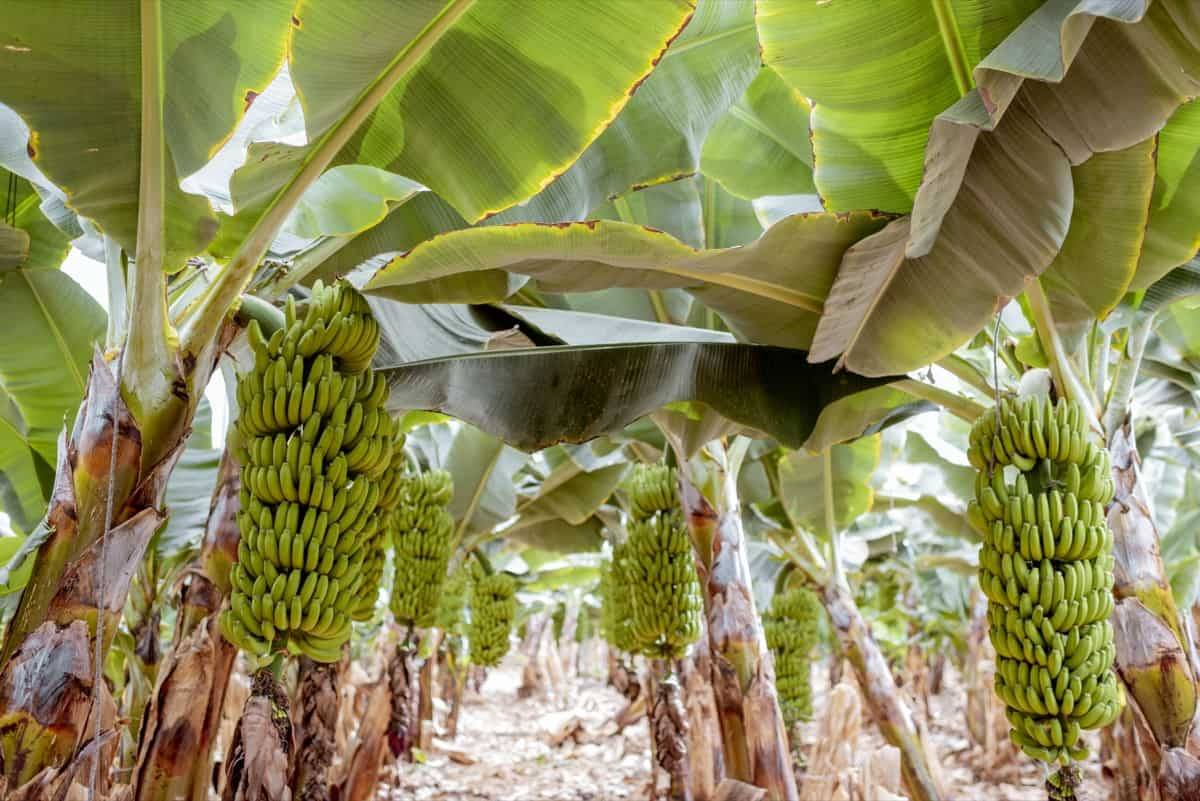
Land Development
| Soil Leveling | Rs.8,000 |
| Digging | Rs. 7,500 |
| Fencing | Rs.20,000 |
| Total | Rs.24,000 |
The recurring production cost for a one-acre orchard includes various components such as planting material, land preparation, inputs application, labor cost, and other farm operations. The recurring production cost for the first three years is estimated to be Rs.25.40 thousand, Rs.14.70 thousand, and Rs.14.30 thousand, respectively. The expected yield from the plantation is estimated to be 22 tonnes per acre, with a total realization of Rs.1.43 lakhs.
Conclusion
High-density banana plantation with optimal spacing and a higher number of plants per acre, using techniques like drip irrigation and fertigation, has the potential to increase yield significantly. This sustainable approach ensures efficient resource utilization and enhances the profitability of banana cultivation.
- Economical Aquaculture: A Guide to Low-Budget Fish Farming
- 15 Common Planting Errors That Can Doom Your Fruit Trees
- How to Make Houseplants Bushy: Effective Tips and Ideas
- Innovative Strategies for Boosting Coconut Pollination and Yield
- Pollination Strategies for Maximum Pumpkin Yield
- The Complete Guide to Chicken Fattening: Strategies for Maximum Growth
- Natural Solutions for Tulip Problems: 100% Effective Remedies for Leaf and Bulb-Related Issues
- Revolutionizing Citrus Preservation: Towards a Healthier, Greener Future
- Natural Solutions for Peony Leaf and Flower Problems: 100% Effective Remedies
- Maximizing Profits with Avocado Contract Farming in India: A Comprehensive Guide
- Natural Solutions for Hydrangea Problems: 100% Effective Remedies for Leaf and Flowers
- The Ultimate Guide to Choosing the Perfect Foliage Friend: Bringing Life Indoors
- From Sunlight to Sustainability: 15 Ways to Use Solar Technology in Agriculture
- The Ultimate Guide to Dong Tao Chicken: Exploring from History to Raising
- The Eco-Friendly Makeover: How to Convert Your Unused Swimming Pool into a Fish Pond
- Mastering the Art of Delaware Chicken Farming: Essentials for Healthy Backyard Flocks
- 20 Best Homemade Fertilizers for Money Plant: DIY Recipes and Application Methods
- How to Craft a Comprehensive Free-Range Chicken Farming Business Plan
- Brighten Your Flock: Raising Easter Egger Chickens for Beauty and Bounty
- How to Optimize Your Poultry Egg Farm Business Plan with These Strategies
- Subsidy for Spirulina Cultivation: How Indian Government Schemes Encouraging Spirulina Farmers
- Ultimate Guide to Raising Dominique Chickens: Breeding, Feeding, Egg-Production, and Care
- Mastering the Art of Raising Jersey Giant Chickens: Care, Feeding, and More
- Ultimate Guide to Raising Legbar Chickens: Breeding, Farming Practices, Diet, Egg-Production
- How to Raise Welsummer Chickens: A Comprehensive Guide for Beginners
- How to Protect Indoor Plants in Winter: A Comprehensive Guide
- Ultimate Guide to Grow Bag Gardening: Tips, Tricks, and Planting Ideas for Urban Gardeners
- Guide to Lotus Cultivation: How to Propagate, Plant, Grow, Care, Cost, and Profit
- Agriculture Drone Subsidy Scheme: Government Kisan Subsidy, License, and How to Apply Online
- Ultimate Guide to Raising Araucana Chickens: Breed Profile, Farming Economics, Diet, and Care
- Bringing Hydroponics to Classroom: Importance, Benefits of Learning for School Students
- Ultimate Guide to Raising Polish Chickens: Breed Profile, Farming Economics, Diet, and Care
- Ultimate Guide to Raising Australorp Chickens: Profile, Farming Economics, Egg Production, Diet, and Care
- Silkie Chicken Farming: Raising Practices, Varieties, Egg Production, Diet, and Care
- Sussex Chicken Farming: Raising Practices, Varieties, Egg Production, Diet and Care
- Homemade Feed Formulations for Livestock: Discover Cost-effective Starter to Finisher Feed Recipes